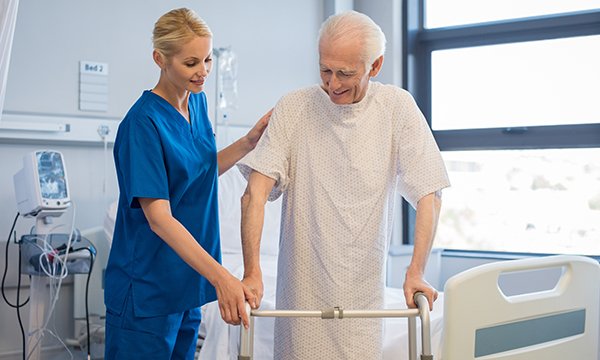Hospital nurses urged to keep older patients moving to reduce risks

Even slow walking for 25 minutes each day in hospital is enough to counter detrimental physical effects of bedrest, study shows

Nurses have an important role to play in keeping older patients moving in hospital to prevent deterioration from bedrest, nursing leaders have said.
It comes as a new study shows even slow walking for 25 minutes each day in hospital is enough to counter the detrimental physical effects of bedrest on older patients.
The optimal amount of walking around hospitals is at least 50 minutes each day, according to the study by the British Journal of Sports Medicine. ‘As little as 25minutes a day of slow-paced walking is sufficient to improve functional capacity and minimise adverse events in this population,’ it said.
Inactivity can lead to a post-hospital syndrome – a period of vulnerability after discharge
Inactivity during hospital spells can lead to a post-hospital syndrome – a period of vulnerability after discharge associated with general physical deconditioning. Researchers said this period of ‘increased vulnerability’ may lead to hospital readmission, disability, nursing home placement, other illnesses and even death.
Advanced nurse practitioner Angeline Price and founder of the End PJ Paralysis campaign Brian Dolan both told Nursing Standard that just small amounts of movement such as encouraging patients to wash and dress themselves or walking them to the bathroom could help reduce the risks posed by bedrest.
Ms Price said: ‘It might not be 25 minutes of walking, it might be helping an older person get up and dressed to sit in a chair for their meal. That potentially could be the difference between them being able to go back home and get to the toilet in between carer visits, for example, or not being able to do that and needing to go into a 24-hour care facility.
‘It might be simple things like helping a person to walk to the bathroom rather than wheeling them on a chair. It’s those few extra tweaks you can make throughout the day. I know when you’re really busy it is easy to bring someone a chair and quickly wheel them to the bathroom, but that’s not doing them any favours.’

Physical activity should become a core part of the daily routine of older adults in hospital, study says
Mr Nolan said patients who are encouraged to move more when in hospital have a decreased risk of falls, are less likely to have pressure sores and are likely to go home sooner. He suggested nurses could ask friends and family members to help with physical activity.
‘Patients and their families are the most untapped resource in healthcare,’ he said. ‘Tell their family member, when they come, to go for a walk with them to the coffee shop in the canteen.
He added that ‘all movement is exercise’ and time-pressed nurses could help in more ways than walking with a patient. Even things like getting them to take their own pillowcase off, because that’s a calisthenic exercise. Don’t get them dressed let them get themselves dressed because they’ll have to do it when they go home,’ he said.
The authors of the new study, led by academics from Spain, said physical activity should become a core part of the daily routine of older adults in hospital.
In other news
- ‘I know of nurses from India living in terrible conditions’ in the UK
- Nurses offered COVID booster to prevent winter staff absences
- Periods at work: trust offers free sanitary products to staff


